7-Eleven's International Marketing Management Report: India Expansion
VerifiedAdded on 2020/05/16
|17
|4606
|204
Report
AI Summary
This report analyzes the international marketing management strategies of 7-Eleven, focusing on its potential expansion into the Indian market. It begins with a company background, market overview, and international opportunities, followed by an examination of key considerations for international marketing, including risk factors (political, market, operational, ownership, and financial) and motivational drivers. The report also explores international marketing communication, detailing the IMC process and its benefits. A SWOT analysis of 7-Eleven is provided to assess its strengths, weaknesses, opportunities, and threats. Finally, the report offers recommendations to 7-Eleven's management, emphasizing the use of social media for promotion and effective financial management. The report aims to provide insights into the challenges and opportunities associated with entering the Indian market and offers a comprehensive overview of the international marketing plan, referencing various sources to support its findings.
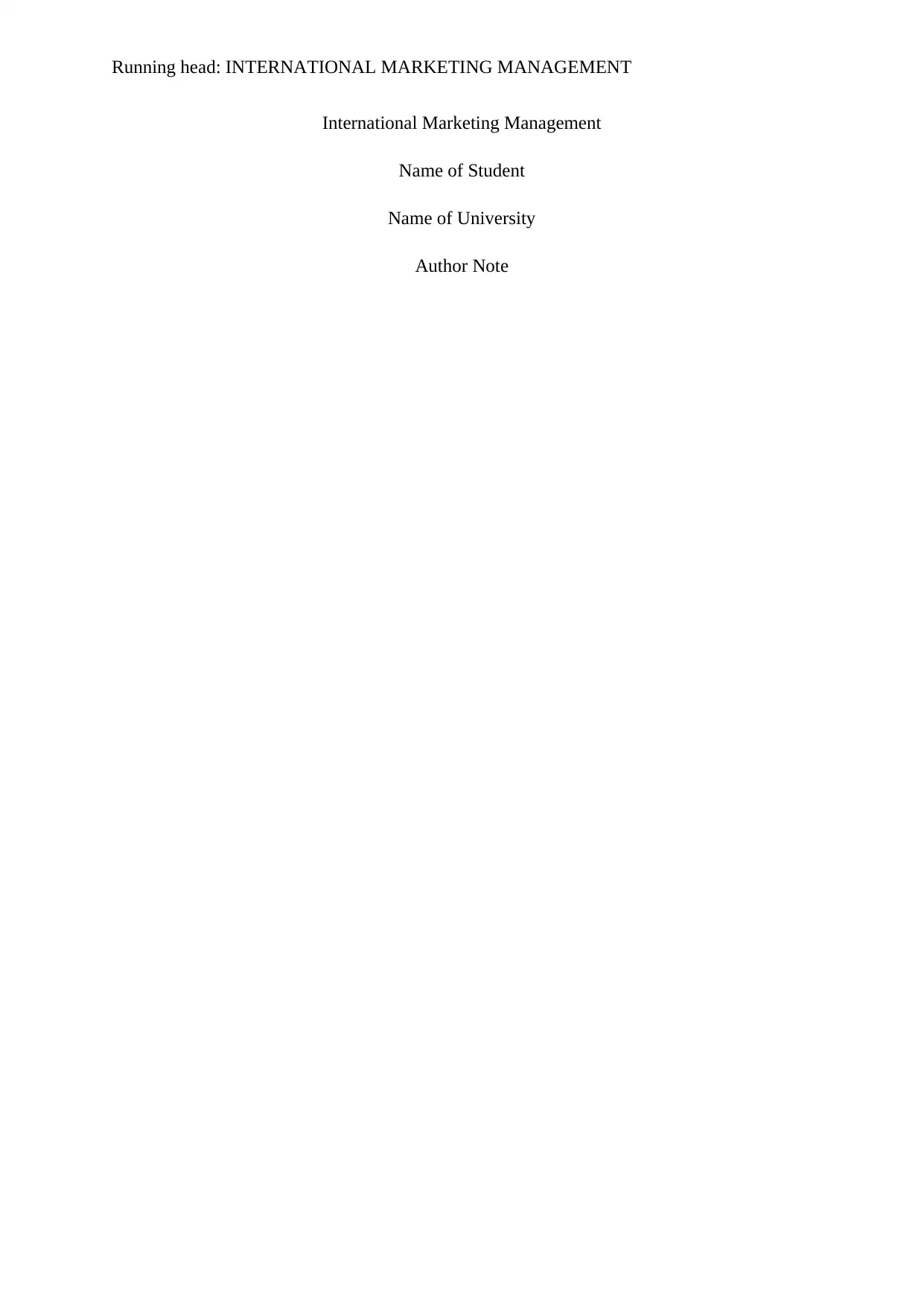
Running head: INTERNATIONAL MARKETING MANAGEMENT
International Marketing Management
Name of Student
Name of University
Author Note
International Marketing Management
Name of Student
Name of University
Author Note
Paraphrase This Document
Need a fresh take? Get an instant paraphrase of this document with our AI Paraphraser
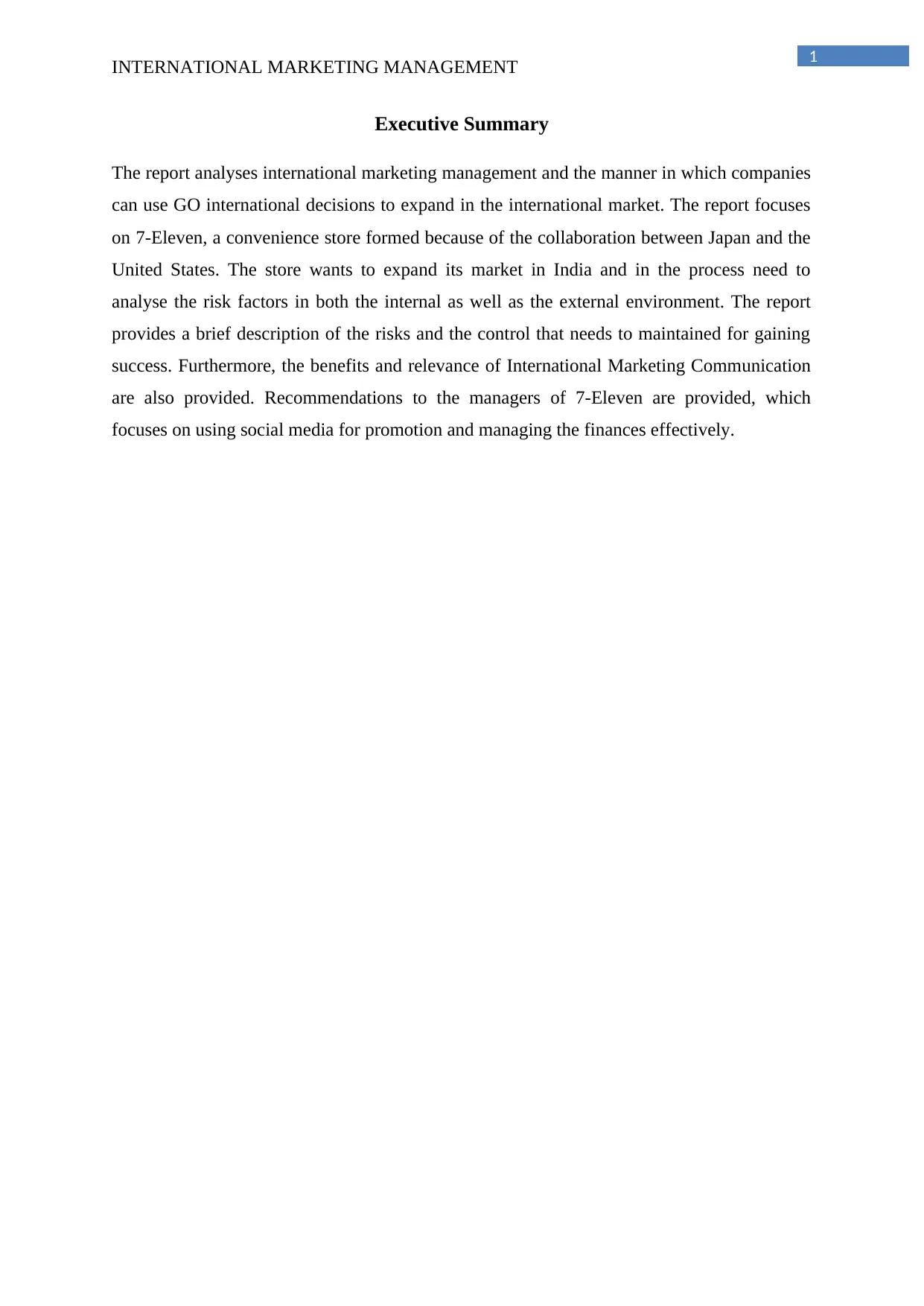
1
INTERNATIONAL MARKETING MANAGEMENT
Executive Summary
The report analyses international marketing management and the manner in which companies
can use GO international decisions to expand in the international market. The report focuses
on 7-Eleven, a convenience store formed because of the collaboration between Japan and the
United States. The store wants to expand its market in India and in the process need to
analyse the risk factors in both the internal as well as the external environment. The report
provides a brief description of the risks and the control that needs to maintained for gaining
success. Furthermore, the benefits and relevance of International Marketing Communication
are also provided. Recommendations to the managers of 7-Eleven are provided, which
focuses on using social media for promotion and managing the finances effectively.
INTERNATIONAL MARKETING MANAGEMENT
Executive Summary
The report analyses international marketing management and the manner in which companies
can use GO international decisions to expand in the international market. The report focuses
on 7-Eleven, a convenience store formed because of the collaboration between Japan and the
United States. The store wants to expand its market in India and in the process need to
analyse the risk factors in both the internal as well as the external environment. The report
provides a brief description of the risks and the control that needs to maintained for gaining
success. Furthermore, the benefits and relevance of International Marketing Communication
are also provided. Recommendations to the managers of 7-Eleven are provided, which
focuses on using social media for promotion and managing the finances effectively.
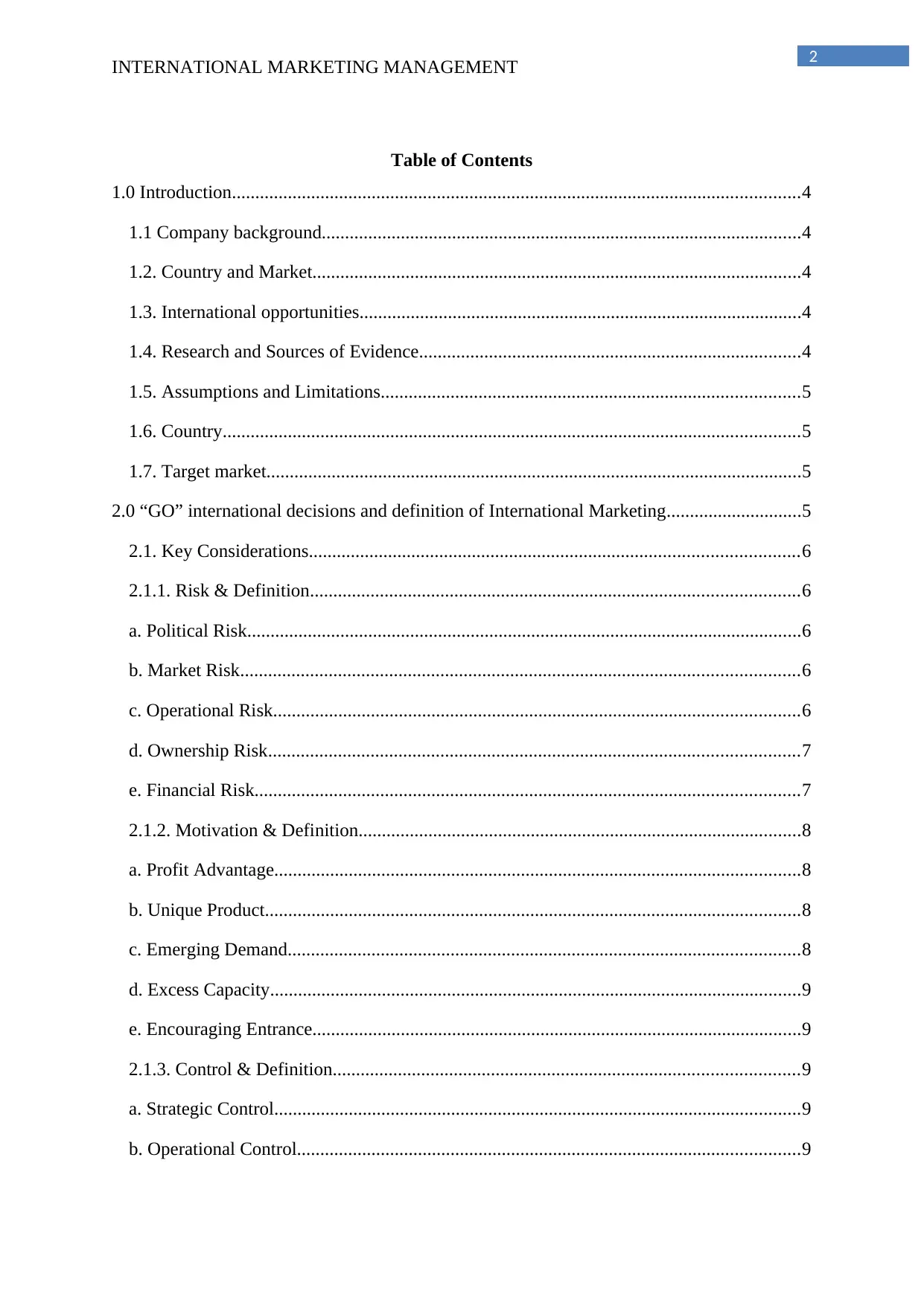
2
INTERNATIONAL MARKETING MANAGEMENT
Table of Contents
1.0 Introduction..........................................................................................................................4
1.1 Company background.......................................................................................................4
1.2. Country and Market.........................................................................................................4
1.3. International opportunities...............................................................................................4
1.4. Research and Sources of Evidence..................................................................................4
1.5. Assumptions and Limitations..........................................................................................5
1.6. Country............................................................................................................................5
1.7. Target market...................................................................................................................5
2.0 “GO” international decisions and definition of International Marketing.............................5
2.1. Key Considerations.........................................................................................................6
2.1.1. Risk & Definition.........................................................................................................6
a. Political Risk.......................................................................................................................6
b. Market Risk........................................................................................................................6
c. Operational Risk.................................................................................................................6
d. Ownership Risk..................................................................................................................7
e. Financial Risk.....................................................................................................................7
2.1.2. Motivation & Definition...............................................................................................8
a. Profit Advantage.................................................................................................................8
b. Unique Product...................................................................................................................8
c. Emerging Demand..............................................................................................................8
d. Excess Capacity..................................................................................................................9
e. Encouraging Entrance.........................................................................................................9
2.1.3. Control & Definition....................................................................................................9
a. Strategic Control.................................................................................................................9
b. Operational Control............................................................................................................9
INTERNATIONAL MARKETING MANAGEMENT
Table of Contents
1.0 Introduction..........................................................................................................................4
1.1 Company background.......................................................................................................4
1.2. Country and Market.........................................................................................................4
1.3. International opportunities...............................................................................................4
1.4. Research and Sources of Evidence..................................................................................4
1.5. Assumptions and Limitations..........................................................................................5
1.6. Country............................................................................................................................5
1.7. Target market...................................................................................................................5
2.0 “GO” international decisions and definition of International Marketing.............................5
2.1. Key Considerations.........................................................................................................6
2.1.1. Risk & Definition.........................................................................................................6
a. Political Risk.......................................................................................................................6
b. Market Risk........................................................................................................................6
c. Operational Risk.................................................................................................................6
d. Ownership Risk..................................................................................................................7
e. Financial Risk.....................................................................................................................7
2.1.2. Motivation & Definition...............................................................................................8
a. Profit Advantage.................................................................................................................8
b. Unique Product...................................................................................................................8
c. Emerging Demand..............................................................................................................8
d. Excess Capacity..................................................................................................................9
e. Encouraging Entrance.........................................................................................................9
2.1.3. Control & Definition....................................................................................................9
a. Strategic Control.................................................................................................................9
b. Operational Control............................................................................................................9
⊘ This is a preview!⊘
Do you want full access?
Subscribe today to unlock all pages.

Trusted by 1+ million students worldwide
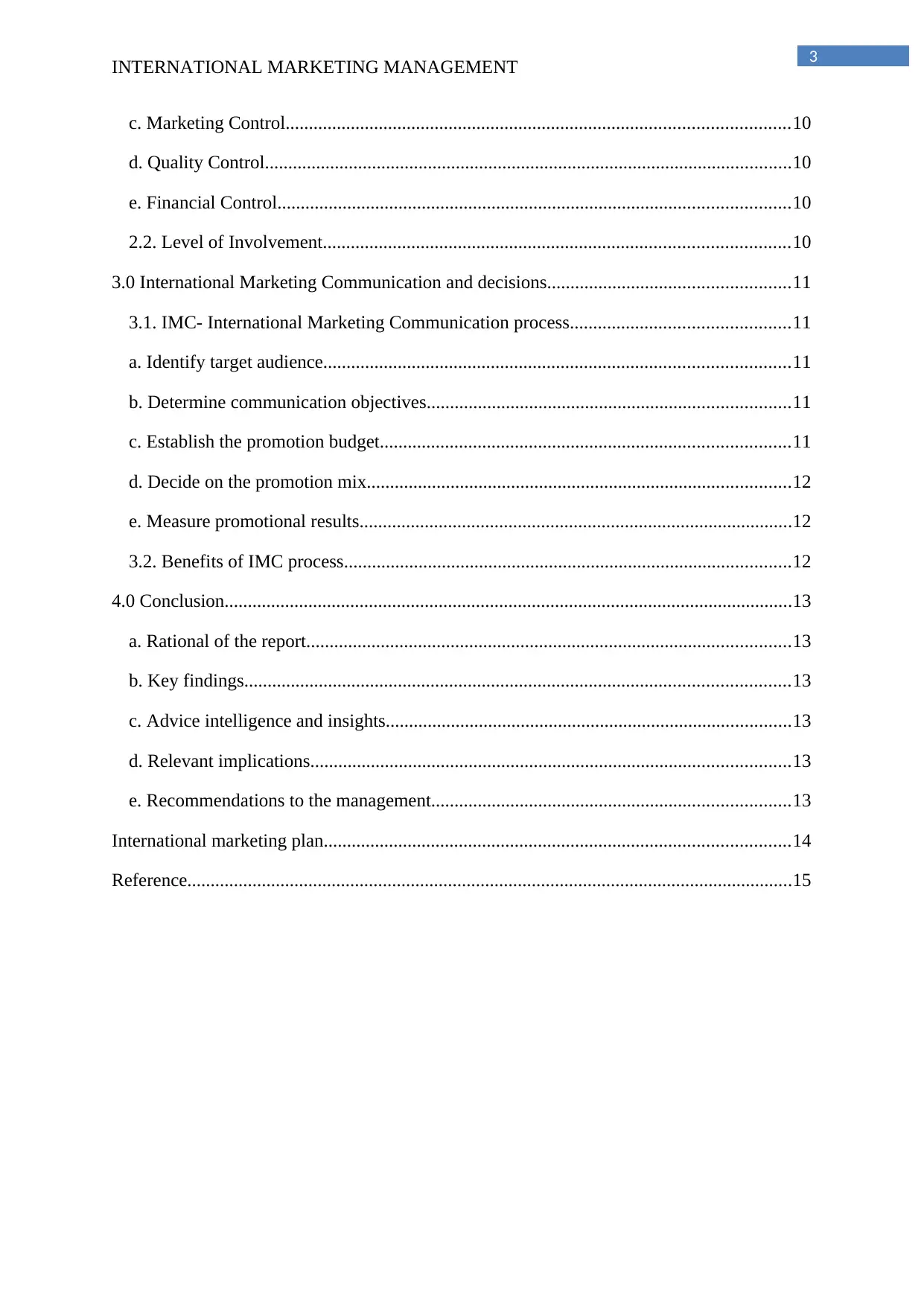
3
INTERNATIONAL MARKETING MANAGEMENT
c. Marketing Control............................................................................................................10
d. Quality Control.................................................................................................................10
e. Financial Control..............................................................................................................10
2.2. Level of Involvement....................................................................................................10
3.0 International Marketing Communication and decisions....................................................11
3.1. IMC- International Marketing Communication process...............................................11
a. Identify target audience....................................................................................................11
b. Determine communication objectives..............................................................................11
c. Establish the promotion budget........................................................................................11
d. Decide on the promotion mix...........................................................................................12
e. Measure promotional results.............................................................................................12
3.2. Benefits of IMC process................................................................................................12
4.0 Conclusion..........................................................................................................................13
a. Rational of the report........................................................................................................13
b. Key findings.....................................................................................................................13
c. Advice intelligence and insights.......................................................................................13
d. Relevant implications.......................................................................................................13
e. Recommendations to the management.............................................................................13
International marketing plan....................................................................................................14
Reference..................................................................................................................................15
INTERNATIONAL MARKETING MANAGEMENT
c. Marketing Control............................................................................................................10
d. Quality Control.................................................................................................................10
e. Financial Control..............................................................................................................10
2.2. Level of Involvement....................................................................................................10
3.0 International Marketing Communication and decisions....................................................11
3.1. IMC- International Marketing Communication process...............................................11
a. Identify target audience....................................................................................................11
b. Determine communication objectives..............................................................................11
c. Establish the promotion budget........................................................................................11
d. Decide on the promotion mix...........................................................................................12
e. Measure promotional results.............................................................................................12
3.2. Benefits of IMC process................................................................................................12
4.0 Conclusion..........................................................................................................................13
a. Rational of the report........................................................................................................13
b. Key findings.....................................................................................................................13
c. Advice intelligence and insights.......................................................................................13
d. Relevant implications.......................................................................................................13
e. Recommendations to the management.............................................................................13
International marketing plan....................................................................................................14
Reference..................................................................................................................................15
Paraphrase This Document
Need a fresh take? Get an instant paraphrase of this document with our AI Paraphraser
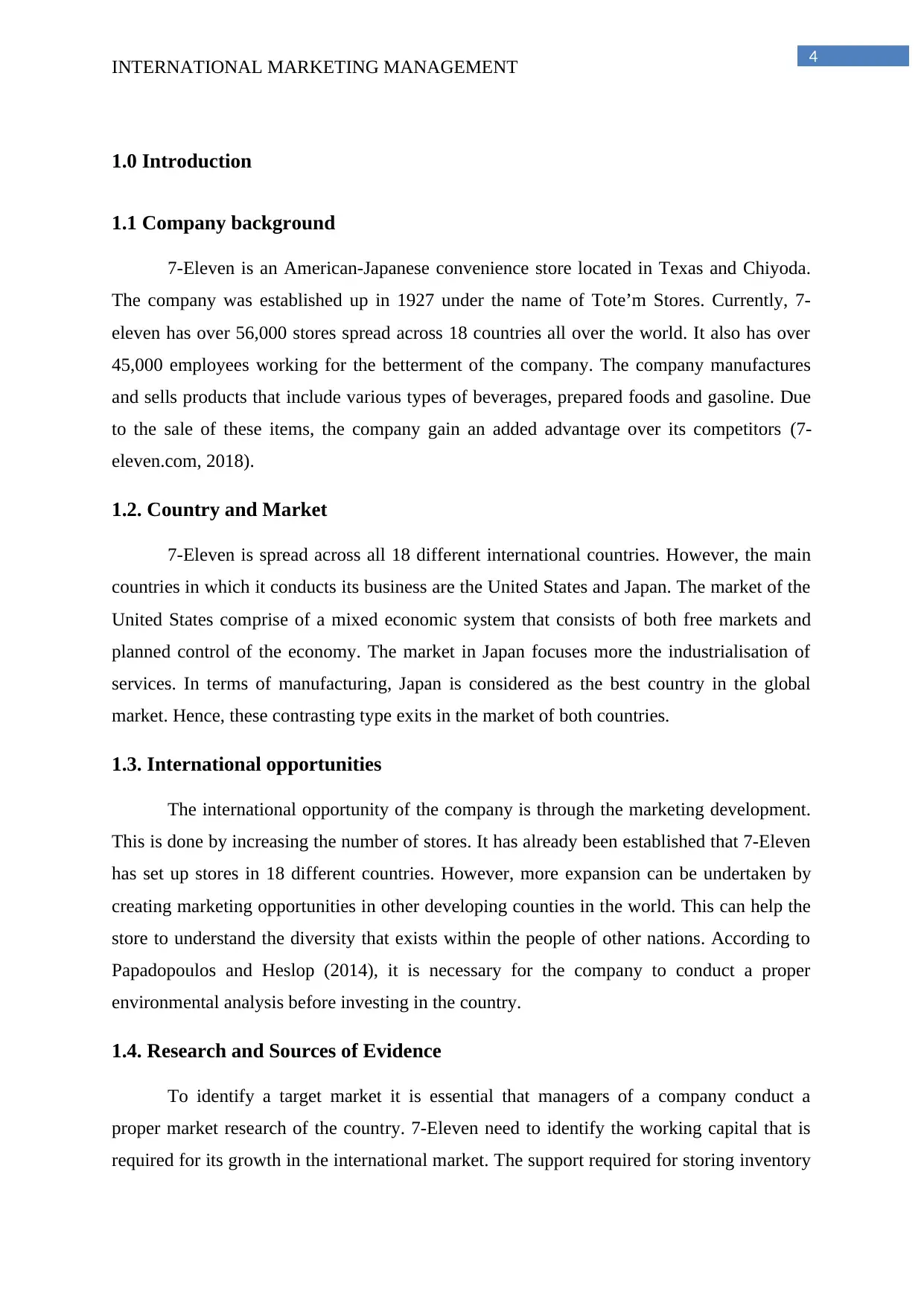
4
INTERNATIONAL MARKETING MANAGEMENT
1.0 Introduction
1.1 Company background
7-Eleven is an American-Japanese convenience store located in Texas and Chiyoda.
The company was established up in 1927 under the name of Tote’m Stores. Currently, 7-
eleven has over 56,000 stores spread across 18 countries all over the world. It also has over
45,000 employees working for the betterment of the company. The company manufactures
and sells products that include various types of beverages, prepared foods and gasoline. Due
to the sale of these items, the company gain an added advantage over its competitors (7-
eleven.com, 2018).
1.2. Country and Market
7-Eleven is spread across all 18 different international countries. However, the main
countries in which it conducts its business are the United States and Japan. The market of the
United States comprise of a mixed economic system that consists of both free markets and
planned control of the economy. The market in Japan focuses more the industrialisation of
services. In terms of manufacturing, Japan is considered as the best country in the global
market. Hence, these contrasting type exits in the market of both countries.
1.3. International opportunities
The international opportunity of the company is through the marketing development.
This is done by increasing the number of stores. It has already been established that 7-Eleven
has set up stores in 18 different countries. However, more expansion can be undertaken by
creating marketing opportunities in other developing counties in the world. This can help the
store to understand the diversity that exists within the people of other nations. According to
Papadopoulos and Heslop (2014), it is necessary for the company to conduct a proper
environmental analysis before investing in the country.
1.4. Research and Sources of Evidence
To identify a target market it is essential that managers of a company conduct a
proper market research of the country. 7-Eleven need to identify the working capital that is
required for its growth in the international market. The support required for storing inventory
INTERNATIONAL MARKETING MANAGEMENT
1.0 Introduction
1.1 Company background
7-Eleven is an American-Japanese convenience store located in Texas and Chiyoda.
The company was established up in 1927 under the name of Tote’m Stores. Currently, 7-
eleven has over 56,000 stores spread across 18 countries all over the world. It also has over
45,000 employees working for the betterment of the company. The company manufactures
and sells products that include various types of beverages, prepared foods and gasoline. Due
to the sale of these items, the company gain an added advantage over its competitors (7-
eleven.com, 2018).
1.2. Country and Market
7-Eleven is spread across all 18 different international countries. However, the main
countries in which it conducts its business are the United States and Japan. The market of the
United States comprise of a mixed economic system that consists of both free markets and
planned control of the economy. The market in Japan focuses more the industrialisation of
services. In terms of manufacturing, Japan is considered as the best country in the global
market. Hence, these contrasting type exits in the market of both countries.
1.3. International opportunities
The international opportunity of the company is through the marketing development.
This is done by increasing the number of stores. It has already been established that 7-Eleven
has set up stores in 18 different countries. However, more expansion can be undertaken by
creating marketing opportunities in other developing counties in the world. This can help the
store to understand the diversity that exists within the people of other nations. According to
Papadopoulos and Heslop (2014), it is necessary for the company to conduct a proper
environmental analysis before investing in the country.
1.4. Research and Sources of Evidence
To identify a target market it is essential that managers of a company conduct a
proper market research of the country. 7-Eleven need to identify the working capital that is
required for its growth in the international market. The support required for storing inventory
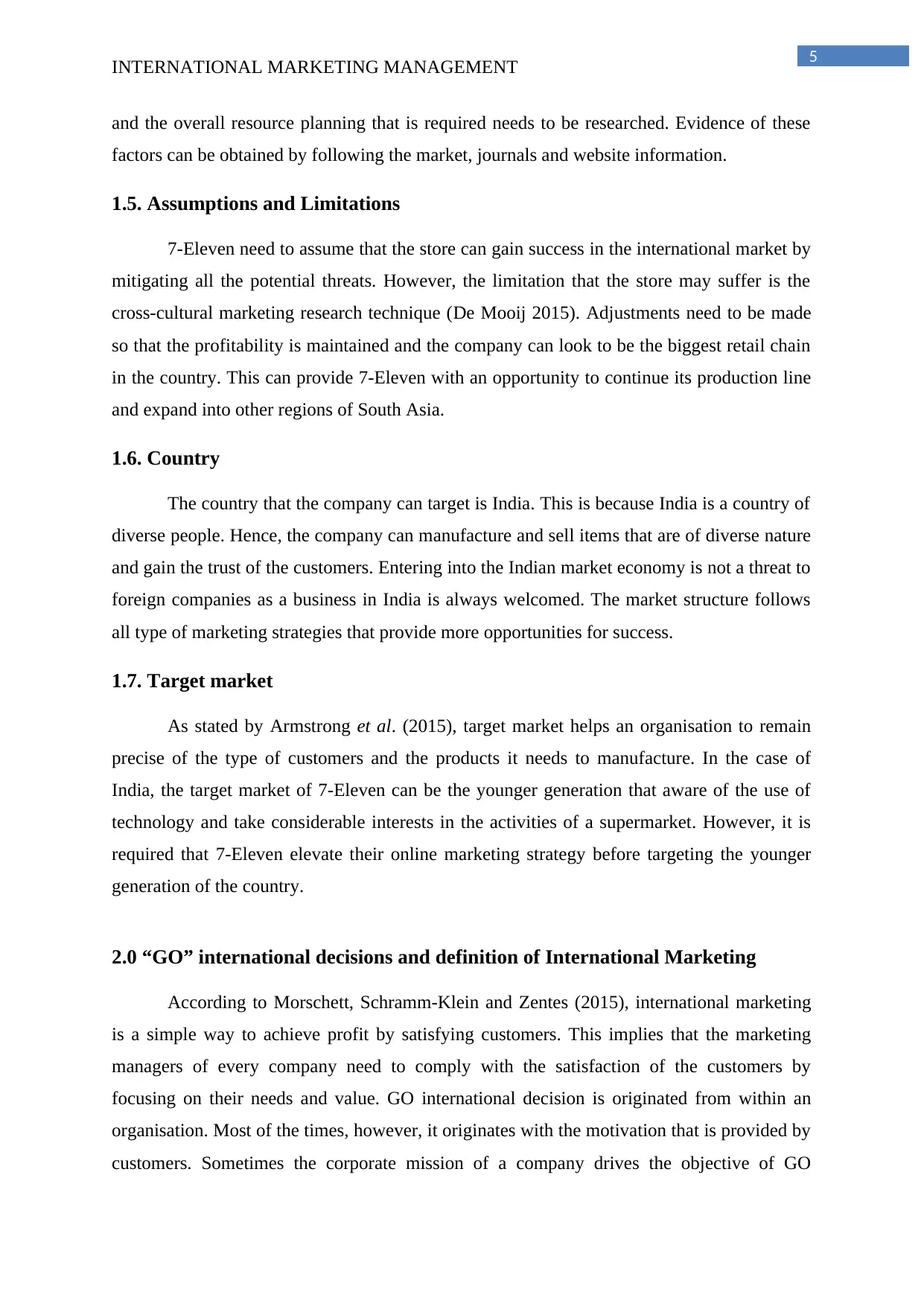
5
INTERNATIONAL MARKETING MANAGEMENT
and the overall resource planning that is required needs to be researched. Evidence of these
factors can be obtained by following the market, journals and website information.
1.5. Assumptions and Limitations
7-Eleven need to assume that the store can gain success in the international market by
mitigating all the potential threats. However, the limitation that the store may suffer is the
cross-cultural marketing research technique (De Mooij 2015). Adjustments need to be made
so that the profitability is maintained and the company can look to be the biggest retail chain
in the country. This can provide 7-Eleven with an opportunity to continue its production line
and expand into other regions of South Asia.
1.6. Country
The country that the company can target is India. This is because India is a country of
diverse people. Hence, the company can manufacture and sell items that are of diverse nature
and gain the trust of the customers. Entering into the Indian market economy is not a threat to
foreign companies as a business in India is always welcomed. The market structure follows
all type of marketing strategies that provide more opportunities for success.
1.7. Target market
As stated by Armstrong et al. (2015), target market helps an organisation to remain
precise of the type of customers and the products it needs to manufacture. In the case of
India, the target market of 7-Eleven can be the younger generation that aware of the use of
technology and take considerable interests in the activities of a supermarket. However, it is
required that 7-Eleven elevate their online marketing strategy before targeting the younger
generation of the country.
2.0 “GO” international decisions and definition of International Marketing
According to Morschett, Schramm-Klein and Zentes (2015), international marketing
is a simple way to achieve profit by satisfying customers. This implies that the marketing
managers of every company need to comply with the satisfaction of the customers by
focusing on their needs and value. GO international decision is originated from within an
organisation. Most of the times, however, it originates with the motivation that is provided by
customers. Sometimes the corporate mission of a company drives the objective of GO
INTERNATIONAL MARKETING MANAGEMENT
and the overall resource planning that is required needs to be researched. Evidence of these
factors can be obtained by following the market, journals and website information.
1.5. Assumptions and Limitations
7-Eleven need to assume that the store can gain success in the international market by
mitigating all the potential threats. However, the limitation that the store may suffer is the
cross-cultural marketing research technique (De Mooij 2015). Adjustments need to be made
so that the profitability is maintained and the company can look to be the biggest retail chain
in the country. This can provide 7-Eleven with an opportunity to continue its production line
and expand into other regions of South Asia.
1.6. Country
The country that the company can target is India. This is because India is a country of
diverse people. Hence, the company can manufacture and sell items that are of diverse nature
and gain the trust of the customers. Entering into the Indian market economy is not a threat to
foreign companies as a business in India is always welcomed. The market structure follows
all type of marketing strategies that provide more opportunities for success.
1.7. Target market
As stated by Armstrong et al. (2015), target market helps an organisation to remain
precise of the type of customers and the products it needs to manufacture. In the case of
India, the target market of 7-Eleven can be the younger generation that aware of the use of
technology and take considerable interests in the activities of a supermarket. However, it is
required that 7-Eleven elevate their online marketing strategy before targeting the younger
generation of the country.
2.0 “GO” international decisions and definition of International Marketing
According to Morschett, Schramm-Klein and Zentes (2015), international marketing
is a simple way to achieve profit by satisfying customers. This implies that the marketing
managers of every company need to comply with the satisfaction of the customers by
focusing on their needs and value. GO international decision is originated from within an
organisation. Most of the times, however, it originates with the motivation that is provided by
customers. Sometimes the corporate mission of a company drives the objective of GO
⊘ This is a preview!⊘
Do you want full access?
Subscribe today to unlock all pages.

Trusted by 1+ million students worldwide
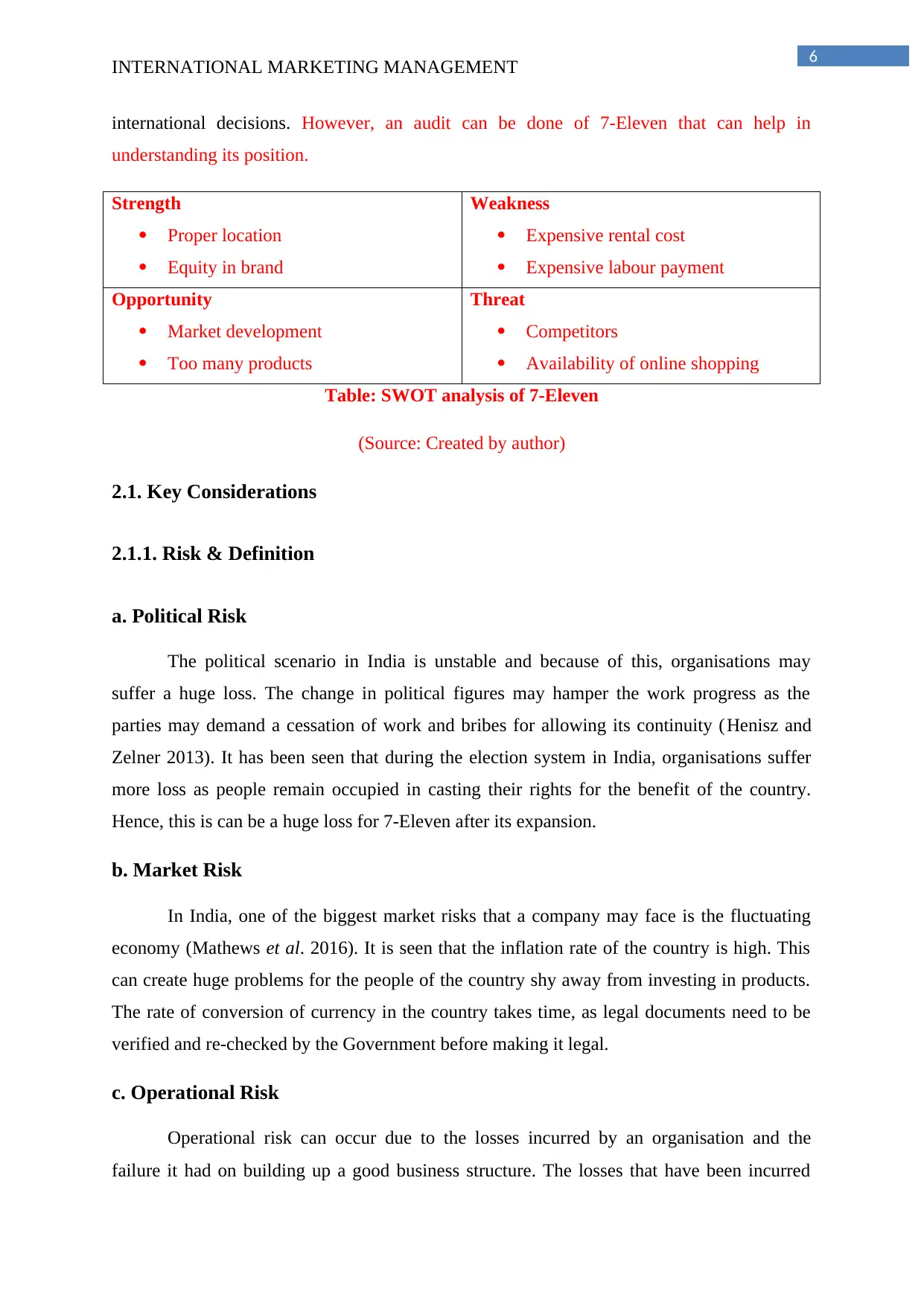
6
INTERNATIONAL MARKETING MANAGEMENT
international decisions. However, an audit can be done of 7-Eleven that can help in
understanding its position.
Strength
Proper location
Equity in brand
Weakness
Expensive rental cost
Expensive labour payment
Opportunity
Market development
Too many products
Threat
Competitors
Availability of online shopping
Table: SWOT analysis of 7-Eleven
(Source: Created by author)
2.1. Key Considerations
2.1.1. Risk & Definition
a. Political Risk
The political scenario in India is unstable and because of this, organisations may
suffer a huge loss. The change in political figures may hamper the work progress as the
parties may demand a cessation of work and bribes for allowing its continuity (Henisz and
Zelner 2013). It has been seen that during the election system in India, organisations suffer
more loss as people remain occupied in casting their rights for the benefit of the country.
Hence, this is can be a huge loss for 7-Eleven after its expansion.
b. Market Risk
In India, one of the biggest market risks that a company may face is the fluctuating
economy (Mathews et al. 2016). It is seen that the inflation rate of the country is high. This
can create huge problems for the people of the country shy away from investing in products.
The rate of conversion of currency in the country takes time, as legal documents need to be
verified and re-checked by the Government before making it legal.
c. Operational Risk
Operational risk can occur due to the losses incurred by an organisation and the
failure it had on building up a good business structure. The losses that have been incurred
INTERNATIONAL MARKETING MANAGEMENT
international decisions. However, an audit can be done of 7-Eleven that can help in
understanding its position.
Strength
Proper location
Equity in brand
Weakness
Expensive rental cost
Expensive labour payment
Opportunity
Market development
Too many products
Threat
Competitors
Availability of online shopping
Table: SWOT analysis of 7-Eleven
(Source: Created by author)
2.1. Key Considerations
2.1.1. Risk & Definition
a. Political Risk
The political scenario in India is unstable and because of this, organisations may
suffer a huge loss. The change in political figures may hamper the work progress as the
parties may demand a cessation of work and bribes for allowing its continuity (Henisz and
Zelner 2013). It has been seen that during the election system in India, organisations suffer
more loss as people remain occupied in casting their rights for the benefit of the country.
Hence, this is can be a huge loss for 7-Eleven after its expansion.
b. Market Risk
In India, one of the biggest market risks that a company may face is the fluctuating
economy (Mathews et al. 2016). It is seen that the inflation rate of the country is high. This
can create huge problems for the people of the country shy away from investing in products.
The rate of conversion of currency in the country takes time, as legal documents need to be
verified and re-checked by the Government before making it legal.
c. Operational Risk
Operational risk can occur due to the losses incurred by an organisation and the
failure it had on building up a good business structure. The losses that have been incurred
Paraphrase This Document
Need a fresh take? Get an instant paraphrase of this document with our AI Paraphraser
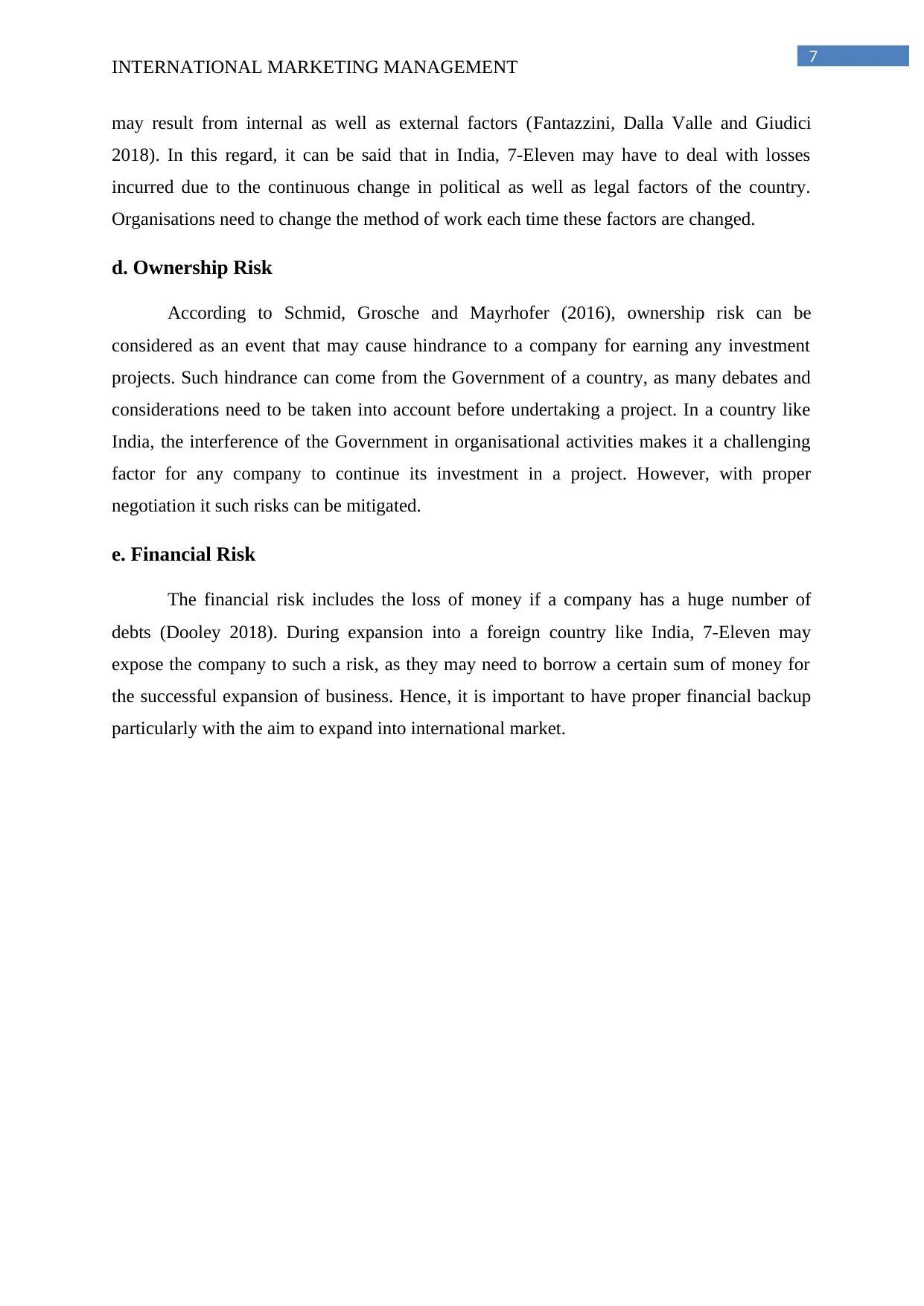
7
INTERNATIONAL MARKETING MANAGEMENT
may result from internal as well as external factors (Fantazzini, Dalla Valle and Giudici
2018). In this regard, it can be said that in India, 7-Eleven may have to deal with losses
incurred due to the continuous change in political as well as legal factors of the country.
Organisations need to change the method of work each time these factors are changed.
d. Ownership Risk
According to Schmid, Grosche and Mayrhofer (2016), ownership risk can be
considered as an event that may cause hindrance to a company for earning any investment
projects. Such hindrance can come from the Government of a country, as many debates and
considerations need to be taken into account before undertaking a project. In a country like
India, the interference of the Government in organisational activities makes it a challenging
factor for any company to continue its investment in a project. However, with proper
negotiation it such risks can be mitigated.
e. Financial Risk
The financial risk includes the loss of money if a company has a huge number of
debts (Dooley 2018). During expansion into a foreign country like India, 7-Eleven may
expose the company to such a risk, as they may need to borrow a certain sum of money for
the successful expansion of business. Hence, it is important to have proper financial backup
particularly with the aim to expand into international market.
RiskFactorsPoliticalRiskMarketriskOperationalriskOwnershipriskFinancialrisk
INTERNATIONAL MARKETING MANAGEMENT
may result from internal as well as external factors (Fantazzini, Dalla Valle and Giudici
2018). In this regard, it can be said that in India, 7-Eleven may have to deal with losses
incurred due to the continuous change in political as well as legal factors of the country.
Organisations need to change the method of work each time these factors are changed.
d. Ownership Risk
According to Schmid, Grosche and Mayrhofer (2016), ownership risk can be
considered as an event that may cause hindrance to a company for earning any investment
projects. Such hindrance can come from the Government of a country, as many debates and
considerations need to be taken into account before undertaking a project. In a country like
India, the interference of the Government in organisational activities makes it a challenging
factor for any company to continue its investment in a project. However, with proper
negotiation it such risks can be mitigated.
e. Financial Risk
The financial risk includes the loss of money if a company has a huge number of
debts (Dooley 2018). During expansion into a foreign country like India, 7-Eleven may
expose the company to such a risk, as they may need to borrow a certain sum of money for
the successful expansion of business. Hence, it is important to have proper financial backup
particularly with the aim to expand into international market.
RiskFactorsPoliticalRiskMarketriskOperationalriskOwnershipriskFinancialrisk
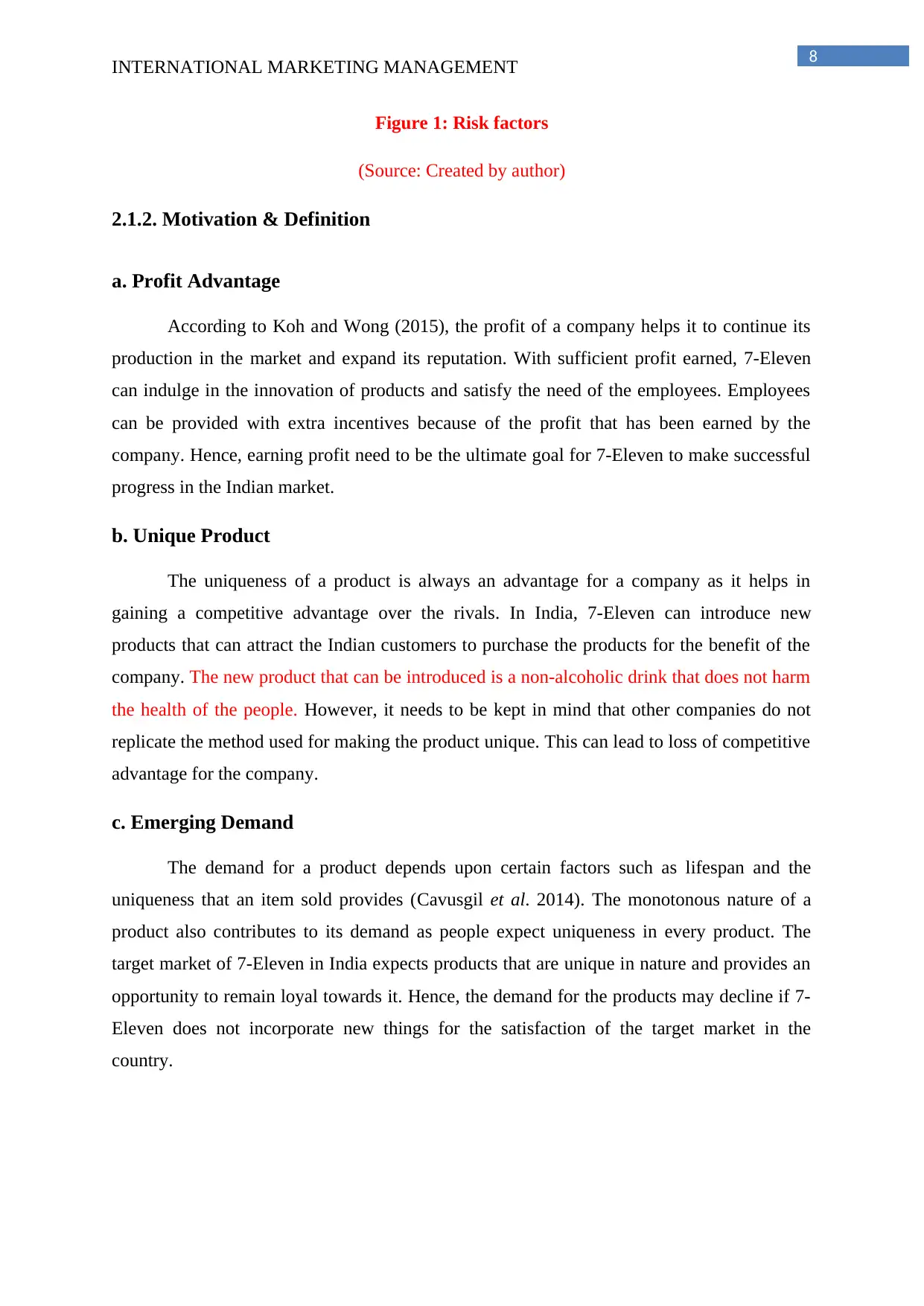
8
INTERNATIONAL MARKETING MANAGEMENT
Figure 1: Risk factors
(Source: Created by author)
2.1.2. Motivation & Definition
a. Profit Advantage
According to Koh and Wong (2015), the profit of a company helps it to continue its
production in the market and expand its reputation. With sufficient profit earned, 7-Eleven
can indulge in the innovation of products and satisfy the need of the employees. Employees
can be provided with extra incentives because of the profit that has been earned by the
company. Hence, earning profit need to be the ultimate goal for 7-Eleven to make successful
progress in the Indian market.
b. Unique Product
The uniqueness of a product is always an advantage for a company as it helps in
gaining a competitive advantage over the rivals. In India, 7-Eleven can introduce new
products that can attract the Indian customers to purchase the products for the benefit of the
company. The new product that can be introduced is a non-alcoholic drink that does not harm
the health of the people. However, it needs to be kept in mind that other companies do not
replicate the method used for making the product unique. This can lead to loss of competitive
advantage for the company.
c. Emerging Demand
The demand for a product depends upon certain factors such as lifespan and the
uniqueness that an item sold provides (Cavusgil et al. 2014). The monotonous nature of a
product also contributes to its demand as people expect uniqueness in every product. The
target market of 7-Eleven in India expects products that are unique in nature and provides an
opportunity to remain loyal towards it. Hence, the demand for the products may decline if 7-
Eleven does not incorporate new things for the satisfaction of the target market in the
country.
INTERNATIONAL MARKETING MANAGEMENT
Figure 1: Risk factors
(Source: Created by author)
2.1.2. Motivation & Definition
a. Profit Advantage
According to Koh and Wong (2015), the profit of a company helps it to continue its
production in the market and expand its reputation. With sufficient profit earned, 7-Eleven
can indulge in the innovation of products and satisfy the need of the employees. Employees
can be provided with extra incentives because of the profit that has been earned by the
company. Hence, earning profit need to be the ultimate goal for 7-Eleven to make successful
progress in the Indian market.
b. Unique Product
The uniqueness of a product is always an advantage for a company as it helps in
gaining a competitive advantage over the rivals. In India, 7-Eleven can introduce new
products that can attract the Indian customers to purchase the products for the benefit of the
company. The new product that can be introduced is a non-alcoholic drink that does not harm
the health of the people. However, it needs to be kept in mind that other companies do not
replicate the method used for making the product unique. This can lead to loss of competitive
advantage for the company.
c. Emerging Demand
The demand for a product depends upon certain factors such as lifespan and the
uniqueness that an item sold provides (Cavusgil et al. 2014). The monotonous nature of a
product also contributes to its demand as people expect uniqueness in every product. The
target market of 7-Eleven in India expects products that are unique in nature and provides an
opportunity to remain loyal towards it. Hence, the demand for the products may decline if 7-
Eleven does not incorporate new things for the satisfaction of the target market in the
country.
⊘ This is a preview!⊘
Do you want full access?
Subscribe today to unlock all pages.

Trusted by 1+ million students worldwide
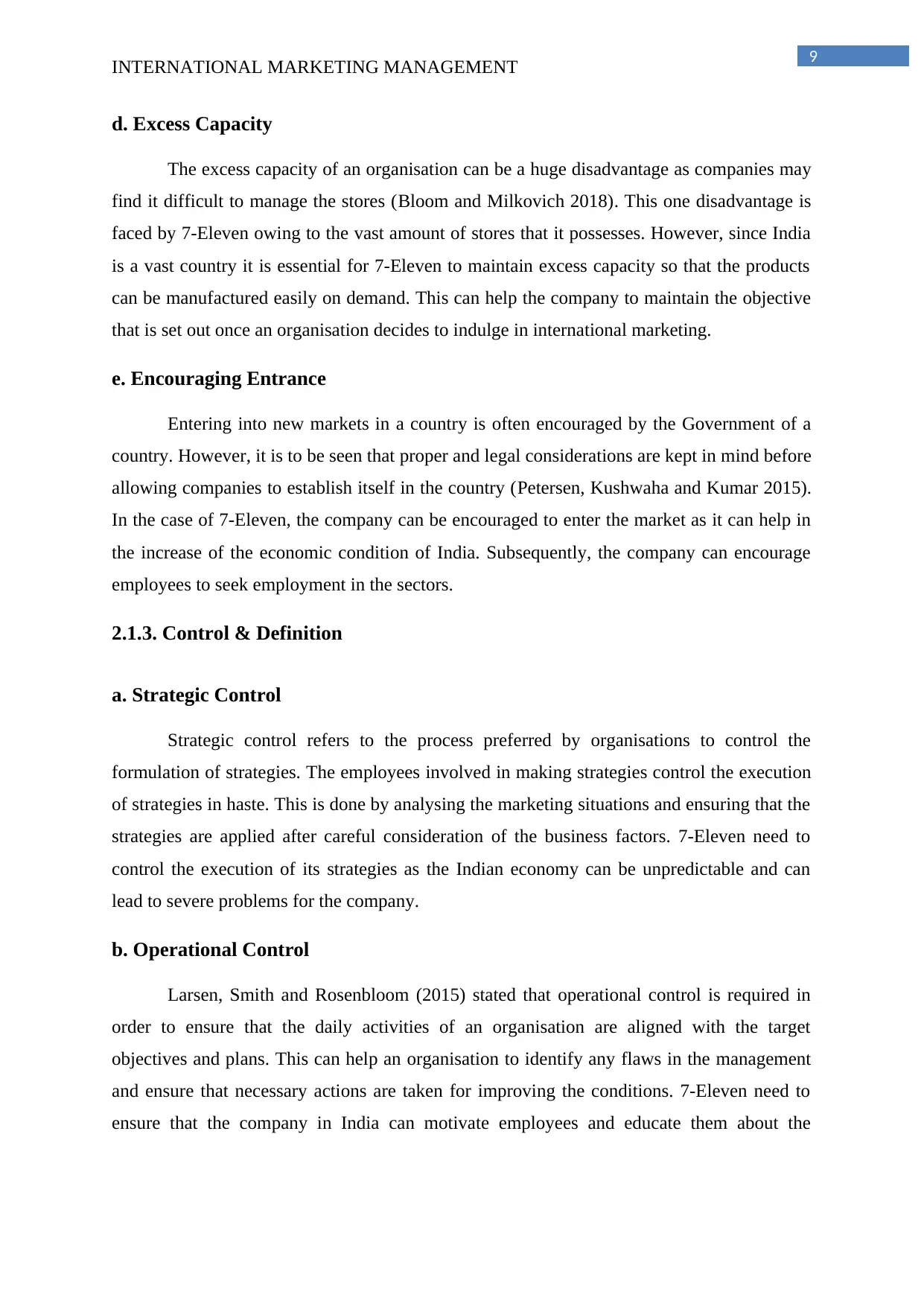
9
INTERNATIONAL MARKETING MANAGEMENT
d. Excess Capacity
The excess capacity of an organisation can be a huge disadvantage as companies may
find it difficult to manage the stores (Bloom and Milkovich 2018). This one disadvantage is
faced by 7-Eleven owing to the vast amount of stores that it possesses. However, since India
is a vast country it is essential for 7-Eleven to maintain excess capacity so that the products
can be manufactured easily on demand. This can help the company to maintain the objective
that is set out once an organisation decides to indulge in international marketing.
e. Encouraging Entrance
Entering into new markets in a country is often encouraged by the Government of a
country. However, it is to be seen that proper and legal considerations are kept in mind before
allowing companies to establish itself in the country (Petersen, Kushwaha and Kumar 2015).
In the case of 7-Eleven, the company can be encouraged to enter the market as it can help in
the increase of the economic condition of India. Subsequently, the company can encourage
employees to seek employment in the sectors.
2.1.3. Control & Definition
a. Strategic Control
Strategic control refers to the process preferred by organisations to control the
formulation of strategies. The employees involved in making strategies control the execution
of strategies in haste. This is done by analysing the marketing situations and ensuring that the
strategies are applied after careful consideration of the business factors. 7-Eleven need to
control the execution of its strategies as the Indian economy can be unpredictable and can
lead to severe problems for the company.
b. Operational Control
Larsen, Smith and Rosenbloom (2015) stated that operational control is required in
order to ensure that the daily activities of an organisation are aligned with the target
objectives and plans. This can help an organisation to identify any flaws in the management
and ensure that necessary actions are taken for improving the conditions. 7-Eleven need to
ensure that the company in India can motivate employees and educate them about the
INTERNATIONAL MARKETING MANAGEMENT
d. Excess Capacity
The excess capacity of an organisation can be a huge disadvantage as companies may
find it difficult to manage the stores (Bloom and Milkovich 2018). This one disadvantage is
faced by 7-Eleven owing to the vast amount of stores that it possesses. However, since India
is a vast country it is essential for 7-Eleven to maintain excess capacity so that the products
can be manufactured easily on demand. This can help the company to maintain the objective
that is set out once an organisation decides to indulge in international marketing.
e. Encouraging Entrance
Entering into new markets in a country is often encouraged by the Government of a
country. However, it is to be seen that proper and legal considerations are kept in mind before
allowing companies to establish itself in the country (Petersen, Kushwaha and Kumar 2015).
In the case of 7-Eleven, the company can be encouraged to enter the market as it can help in
the increase of the economic condition of India. Subsequently, the company can encourage
employees to seek employment in the sectors.
2.1.3. Control & Definition
a. Strategic Control
Strategic control refers to the process preferred by organisations to control the
formulation of strategies. The employees involved in making strategies control the execution
of strategies in haste. This is done by analysing the marketing situations and ensuring that the
strategies are applied after careful consideration of the business factors. 7-Eleven need to
control the execution of its strategies as the Indian economy can be unpredictable and can
lead to severe problems for the company.
b. Operational Control
Larsen, Smith and Rosenbloom (2015) stated that operational control is required in
order to ensure that the daily activities of an organisation are aligned with the target
objectives and plans. This can help an organisation to identify any flaws in the management
and ensure that necessary actions are taken for improving the conditions. 7-Eleven need to
ensure that the company in India can motivate employees and educate them about the
Paraphrase This Document
Need a fresh take? Get an instant paraphrase of this document with our AI Paraphraser
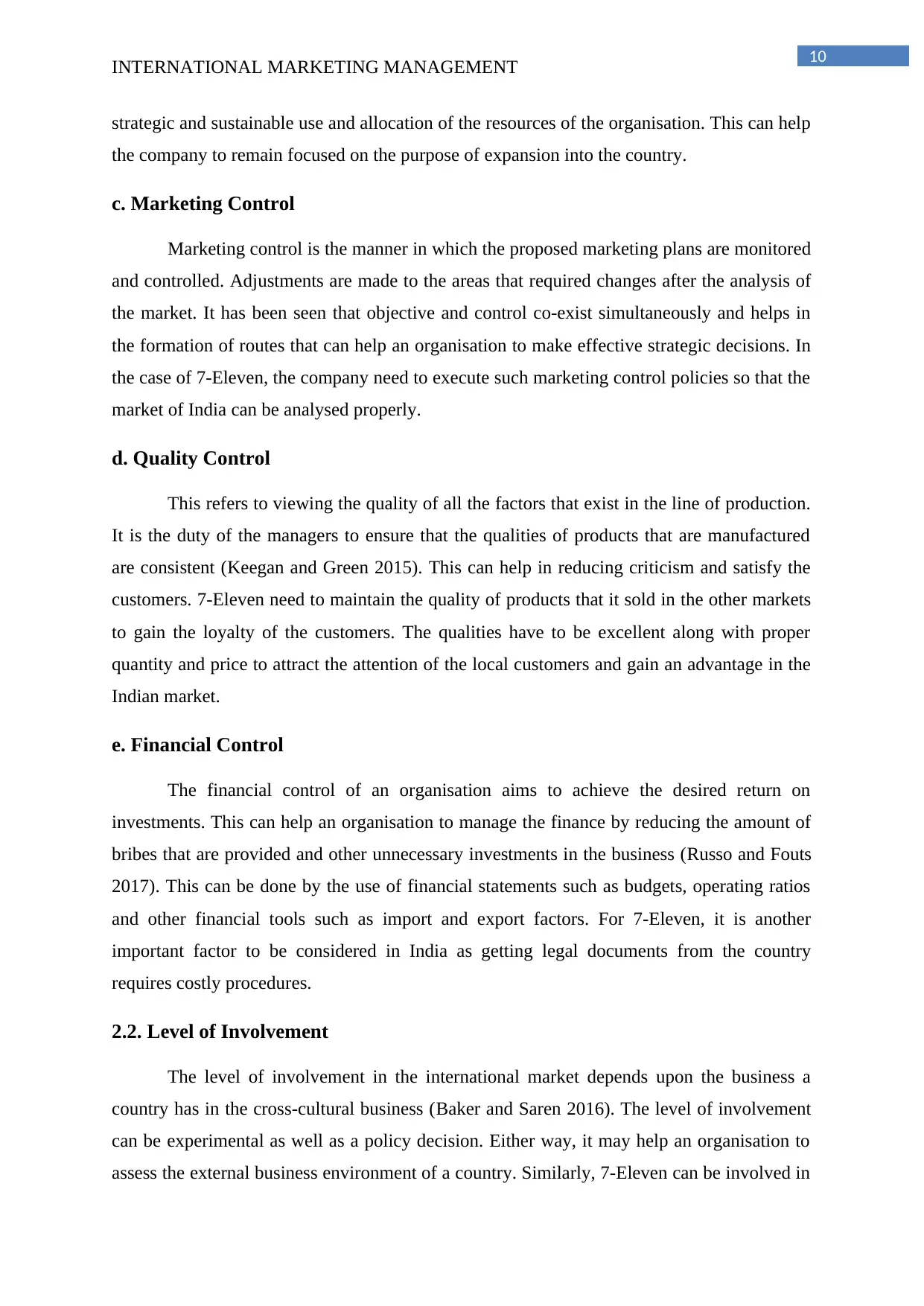
10
INTERNATIONAL MARKETING MANAGEMENT
strategic and sustainable use and allocation of the resources of the organisation. This can help
the company to remain focused on the purpose of expansion into the country.
c. Marketing Control
Marketing control is the manner in which the proposed marketing plans are monitored
and controlled. Adjustments are made to the areas that required changes after the analysis of
the market. It has been seen that objective and control co-exist simultaneously and helps in
the formation of routes that can help an organisation to make effective strategic decisions. In
the case of 7-Eleven, the company need to execute such marketing control policies so that the
market of India can be analysed properly.
d. Quality Control
This refers to viewing the quality of all the factors that exist in the line of production.
It is the duty of the managers to ensure that the qualities of products that are manufactured
are consistent (Keegan and Green 2015). This can help in reducing criticism and satisfy the
customers. 7-Eleven need to maintain the quality of products that it sold in the other markets
to gain the loyalty of the customers. The qualities have to be excellent along with proper
quantity and price to attract the attention of the local customers and gain an advantage in the
Indian market.
e. Financial Control
The financial control of an organisation aims to achieve the desired return on
investments. This can help an organisation to manage the finance by reducing the amount of
bribes that are provided and other unnecessary investments in the business (Russo and Fouts
2017). This can be done by the use of financial statements such as budgets, operating ratios
and other financial tools such as import and export factors. For 7-Eleven, it is another
important factor to be considered in India as getting legal documents from the country
requires costly procedures.
2.2. Level of Involvement
The level of involvement in the international market depends upon the business a
country has in the cross-cultural business (Baker and Saren 2016). The level of involvement
can be experimental as well as a policy decision. Either way, it may help an organisation to
assess the external business environment of a country. Similarly, 7-Eleven can be involved in
INTERNATIONAL MARKETING MANAGEMENT
strategic and sustainable use and allocation of the resources of the organisation. This can help
the company to remain focused on the purpose of expansion into the country.
c. Marketing Control
Marketing control is the manner in which the proposed marketing plans are monitored
and controlled. Adjustments are made to the areas that required changes after the analysis of
the market. It has been seen that objective and control co-exist simultaneously and helps in
the formation of routes that can help an organisation to make effective strategic decisions. In
the case of 7-Eleven, the company need to execute such marketing control policies so that the
market of India can be analysed properly.
d. Quality Control
This refers to viewing the quality of all the factors that exist in the line of production.
It is the duty of the managers to ensure that the qualities of products that are manufactured
are consistent (Keegan and Green 2015). This can help in reducing criticism and satisfy the
customers. 7-Eleven need to maintain the quality of products that it sold in the other markets
to gain the loyalty of the customers. The qualities have to be excellent along with proper
quantity and price to attract the attention of the local customers and gain an advantage in the
Indian market.
e. Financial Control
The financial control of an organisation aims to achieve the desired return on
investments. This can help an organisation to manage the finance by reducing the amount of
bribes that are provided and other unnecessary investments in the business (Russo and Fouts
2017). This can be done by the use of financial statements such as budgets, operating ratios
and other financial tools such as import and export factors. For 7-Eleven, it is another
important factor to be considered in India as getting legal documents from the country
requires costly procedures.
2.2. Level of Involvement
The level of involvement in the international market depends upon the business a
country has in the cross-cultural business (Baker and Saren 2016). The level of involvement
can be experimental as well as a policy decision. Either way, it may help an organisation to
assess the external business environment of a country. Similarly, 7-Eleven can be involved in
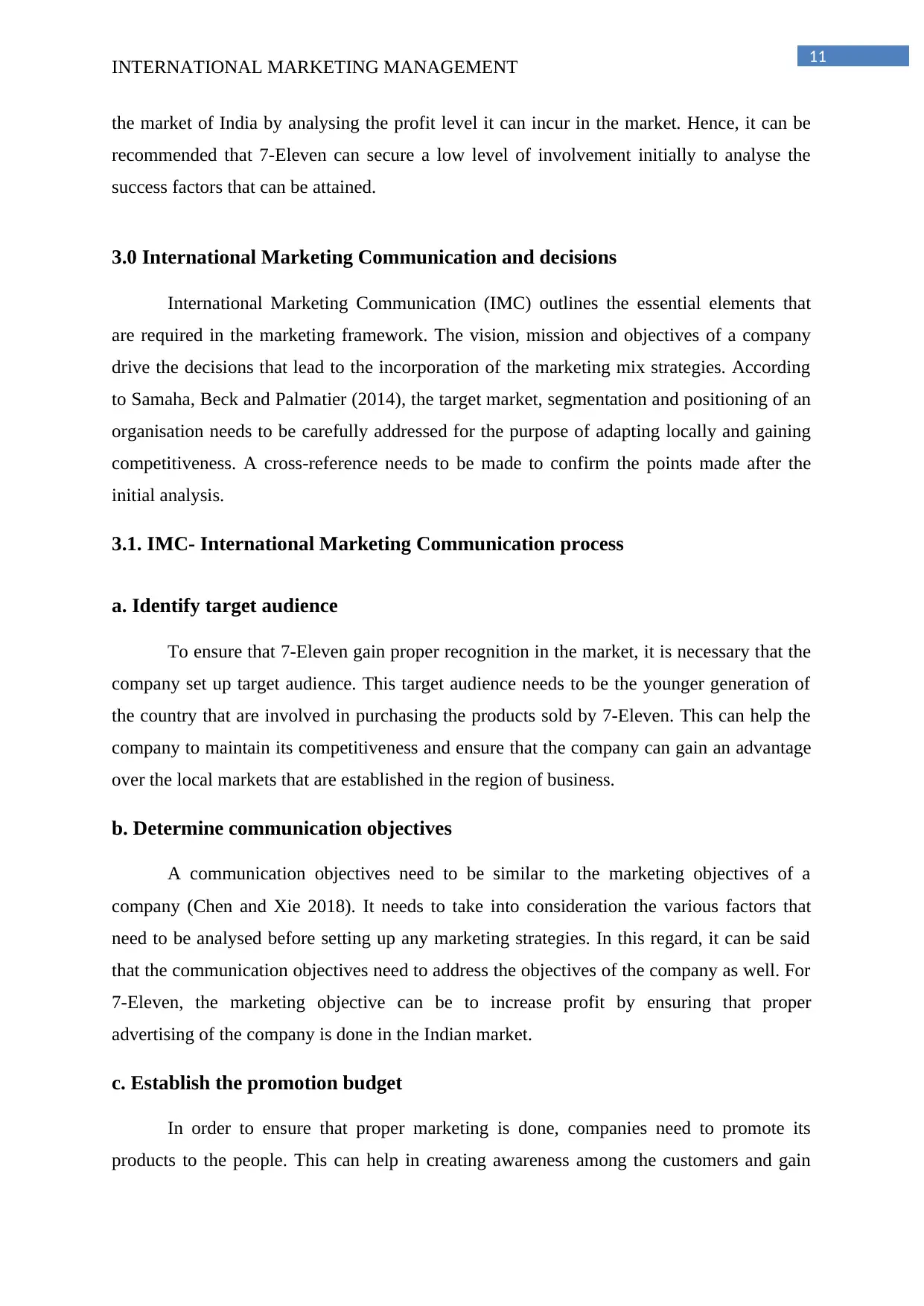
11
INTERNATIONAL MARKETING MANAGEMENT
the market of India by analysing the profit level it can incur in the market. Hence, it can be
recommended that 7-Eleven can secure a low level of involvement initially to analyse the
success factors that can be attained.
3.0 International Marketing Communication and decisions
International Marketing Communication (IMC) outlines the essential elements that
are required in the marketing framework. The vision, mission and objectives of a company
drive the decisions that lead to the incorporation of the marketing mix strategies. According
to Samaha, Beck and Palmatier (2014), the target market, segmentation and positioning of an
organisation needs to be carefully addressed for the purpose of adapting locally and gaining
competitiveness. A cross-reference needs to be made to confirm the points made after the
initial analysis.
3.1. IMC- International Marketing Communication process
a. Identify target audience
To ensure that 7-Eleven gain proper recognition in the market, it is necessary that the
company set up target audience. This target audience needs to be the younger generation of
the country that are involved in purchasing the products sold by 7-Eleven. This can help the
company to maintain its competitiveness and ensure that the company can gain an advantage
over the local markets that are established in the region of business.
b. Determine communication objectives
A communication objectives need to be similar to the marketing objectives of a
company (Chen and Xie 2018). It needs to take into consideration the various factors that
need to be analysed before setting up any marketing strategies. In this regard, it can be said
that the communication objectives need to address the objectives of the company as well. For
7-Eleven, the marketing objective can be to increase profit by ensuring that proper
advertising of the company is done in the Indian market.
c. Establish the promotion budget
In order to ensure that proper marketing is done, companies need to promote its
products to the people. This can help in creating awareness among the customers and gain
INTERNATIONAL MARKETING MANAGEMENT
the market of India by analysing the profit level it can incur in the market. Hence, it can be
recommended that 7-Eleven can secure a low level of involvement initially to analyse the
success factors that can be attained.
3.0 International Marketing Communication and decisions
International Marketing Communication (IMC) outlines the essential elements that
are required in the marketing framework. The vision, mission and objectives of a company
drive the decisions that lead to the incorporation of the marketing mix strategies. According
to Samaha, Beck and Palmatier (2014), the target market, segmentation and positioning of an
organisation needs to be carefully addressed for the purpose of adapting locally and gaining
competitiveness. A cross-reference needs to be made to confirm the points made after the
initial analysis.
3.1. IMC- International Marketing Communication process
a. Identify target audience
To ensure that 7-Eleven gain proper recognition in the market, it is necessary that the
company set up target audience. This target audience needs to be the younger generation of
the country that are involved in purchasing the products sold by 7-Eleven. This can help the
company to maintain its competitiveness and ensure that the company can gain an advantage
over the local markets that are established in the region of business.
b. Determine communication objectives
A communication objectives need to be similar to the marketing objectives of a
company (Chen and Xie 2018). It needs to take into consideration the various factors that
need to be analysed before setting up any marketing strategies. In this regard, it can be said
that the communication objectives need to address the objectives of the company as well. For
7-Eleven, the marketing objective can be to increase profit by ensuring that proper
advertising of the company is done in the Indian market.
c. Establish the promotion budget
In order to ensure that proper marketing is done, companies need to promote its
products to the people. This can help in creating awareness among the customers and gain
⊘ This is a preview!⊘
Do you want full access?
Subscribe today to unlock all pages.

Trusted by 1+ million students worldwide
1 out of 17
Related Documents
Your All-in-One AI-Powered Toolkit for Academic Success.
+13062052269
info@desklib.com
Available 24*7 on WhatsApp / Email
![[object Object]](/_next/static/media/star-bottom.7253800d.svg)
Unlock your academic potential
Copyright © 2020–2025 A2Z Services. All Rights Reserved. Developed and managed by ZUCOL.




